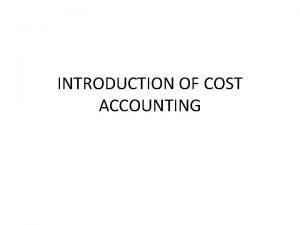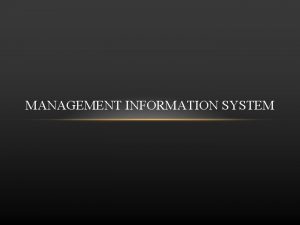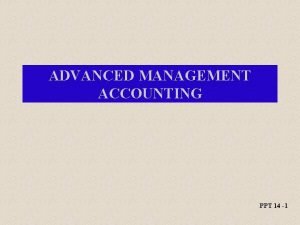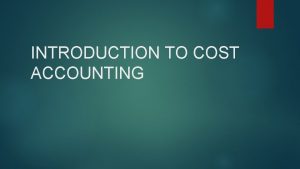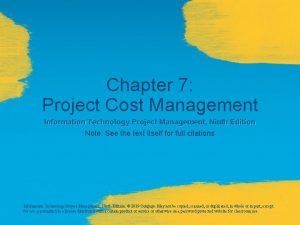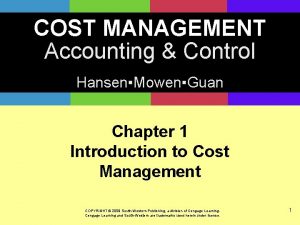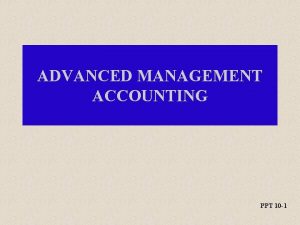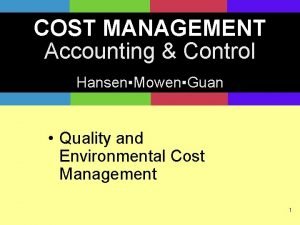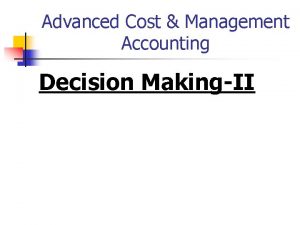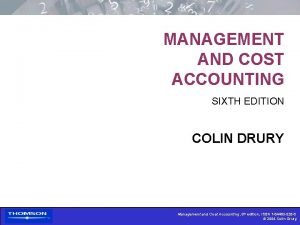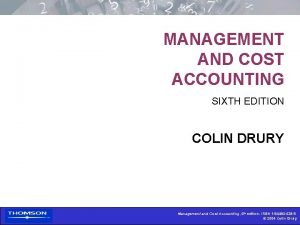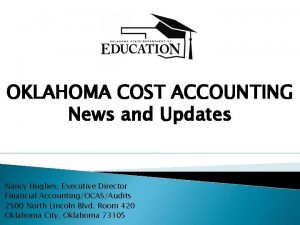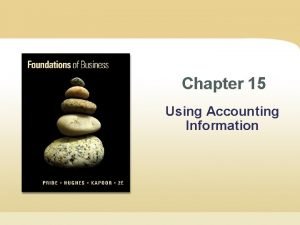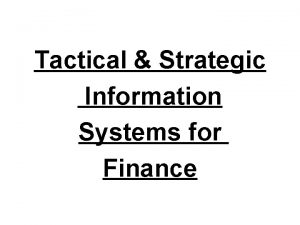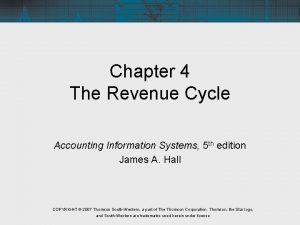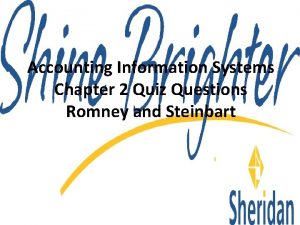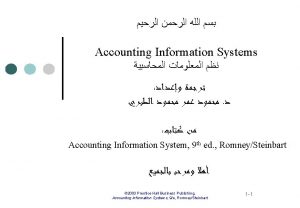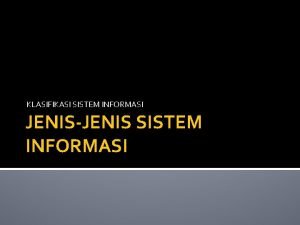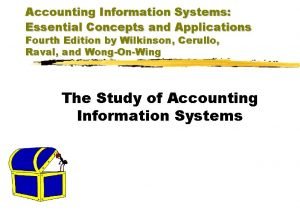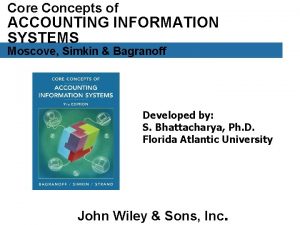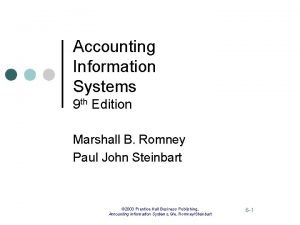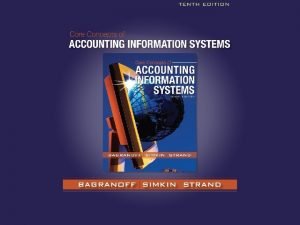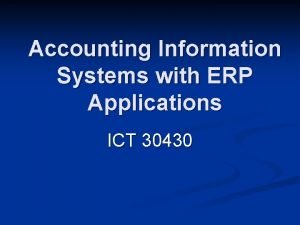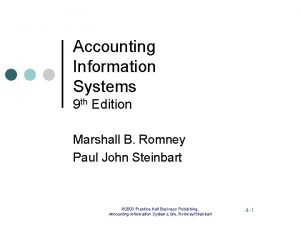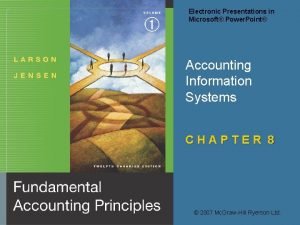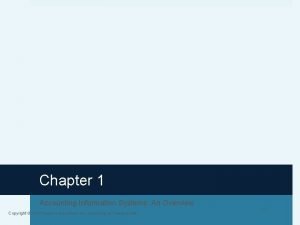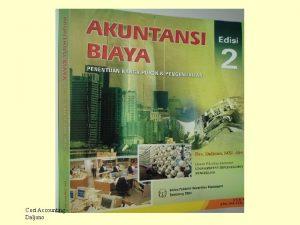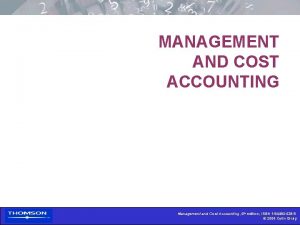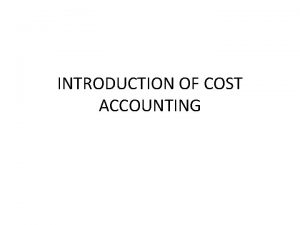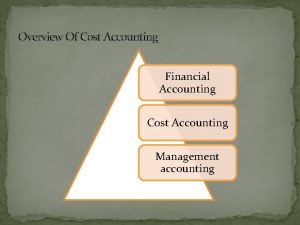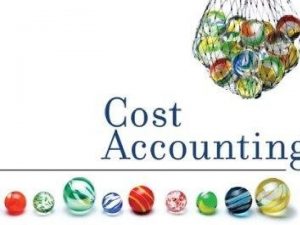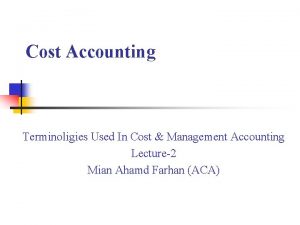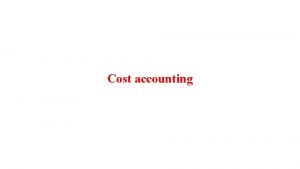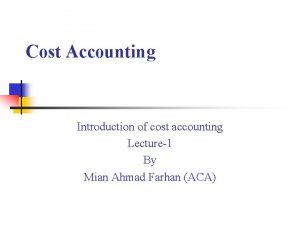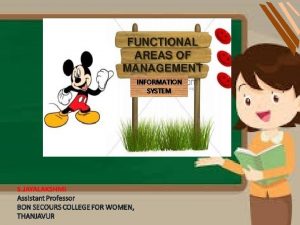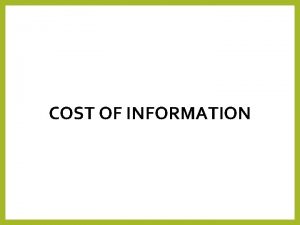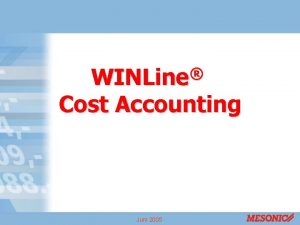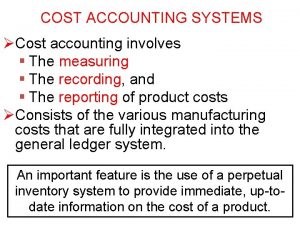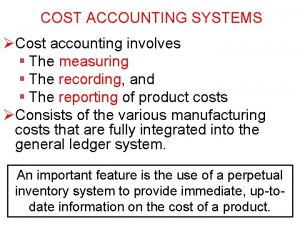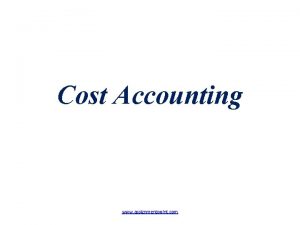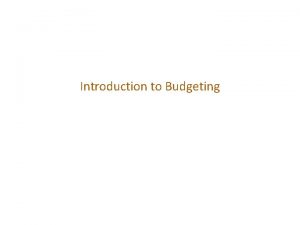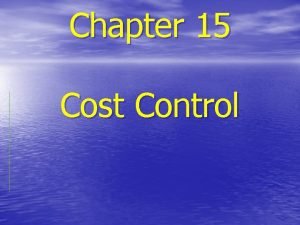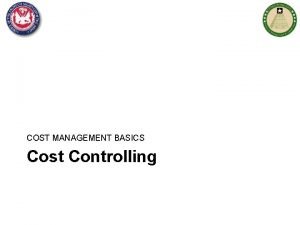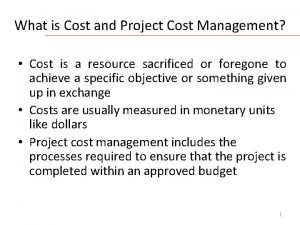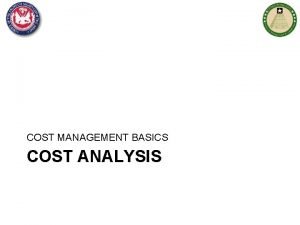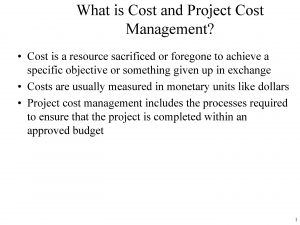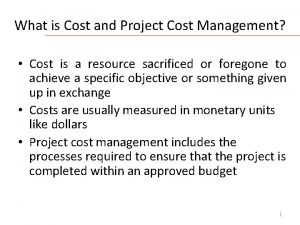INTRODUCTION OF COST ACCOUNTING Management Accounting Information System



































- Slides: 35

INTRODUCTION OF COST ACCOUNTING

Management Accounting Information System Economic Events Collecting Measuring Storing Analyzing Reporting Managing Inputs Processes Users Special Reports Product Costs Customer Costs Budgets Performance Reports Personal Communication Outputs

Management Process The Management Process is defined by the following activities: Planning requires setting Planning Controlling Decision Making objectives and identifying methods to achieve those objectives.

Management Process The Management Process is defined by the Controlling is the following activities: Planning Controlling Decision Making managerial activity of monitoring a plan’s implementation and taking corrective action as needed.

Management Process • The Management Process is defined by the following activities: Planning Controlling Decision Making Control is usually achieved with the use of feedback.

Management Process Feedback is information that can be used to evaluate or correct the steps being taken to implement a plan.

Management Process The Management Process is defined by the following activities: Planning Controlling Decision Making Decision making is the process of choosing among competing alternatives.

Differentiate Between Management Accounting and Financial Accounting

Management Accounting 1. Internally focused Financial Accounting 1. Externally focused

Targeted Users Management accounting focuses on providing information for internal users.

Targeted Users Financial accounting focuses on provided information for external users. ABC Company Annual Report

Management Accounting Financial Accounting 1. Internally focused 1. Externally focused 2. No mandatory rules 2. Must follow externally imposed rules

Restrictions on Inputs and Processes Management accounting is notmust subject to the Financial accounting reporting follow therequirements accounting of generally accepted accounting principles. procedures set by the SEC and the FASB.

Management Accounting Financial Accounting 1. Internally focused 1. Externally focused 2. No mandatory rules 2. Must follow externally imposed rules 3. Financial and nonfinancial informa-tion; subjective information possible 3. Objective financial information

Types of Information For management The restrictions imposed accounting, on financial the financial accounting or tend to produce nonfinancial information objectivemay andbe verifiable much more financial information. subjective in nature.

Management Accounting Financial Accounting 1. Internally focused 1. Externally focused 2. No mandatory rules 2. Must follow externally imposed rules 3. Financial and nonfinancial informa-tion; subjective information possible 3. Objective financial information 4. Emphasis on the future 4. Historical orientation

Time Orientation Management accounting strongly emphasizes providing information about future events.

Time Orientation Financial accounting records and reports events that have already happened.

Management Accounting Financial Accounting 1. Internally focused 1. Externally focused 2. No mandatory rules 2. Must follow externally imposed rules 3. Financial and nonfinancial informa-tion; subjective information possible 3. Objective financial information 4. Emphasis on the future 4. Historical orientation 5. Internal evaluation and decisions based on very detail information 5. Information about the firm as a whole

Degree of Aggregation Management accounting provides measures and internal reports used the evaluate performance of entities, product lines, departments, and managers.

Degree of Aggregation Financial accounting focuses on overall firm performance.

Management Accounting Financial Accounting 1. Internally focused 1. Externally focused 2. No mandatory rules 2. Must follow externally imposed rules 3. Financial and nonfinancial informa-tion; subjective information possible 3. Objective financial information 4. Emphasis on the future 4. Historical orientation 5. Internal evaluation and decisions based on very detail information 5. Information about the firm as a whole 6. Broad, multidisciplinary 6. More self-contained

A cost object is any item such as products, customers, departments, projects, activities, and so on, for which costs are measured and assigned. Example: Example A bicycle is a cost object when you are determining the cost to produce a bicycle. An activity is a basic unit of work performed within an organization. Example: Setting up equipment, moving materials, maintaining equipment, designing products, etc.

• Traceability is the ability to assign a cost to a cost object in an economically feasible way by means of a cause-and-effect relationship. • Direct costs are those costs that can be easily and accurately traced to a cost object. • Example: – – – If a hospital is the cost object, the cost of heating and cooling the hospital is a direct cost.

Indirect costs are those costs that cannot be easily and accurately traced to a cost object. Example: The salary of a plant manager, where departments within the plant are defined as the cost objects.

• Tracing is the actual assignment of costs to a cost object using an observable measure of the resources consumed by the cost object. Tracing costs to cost objects can occur in the following two ways: –Direct tracing is the process of identifying and assigning costs that are exclusively and physically associated with a cost object to that cost object. –Driver tracing is the use of drivers to assign costs to cost objects. Drivers are observable causal factors that measure a cost object’s resource consumption.

Fixed Costs A cost that stays the same as output changes is a fixed cost.

Fixed Costs Cutting machines are leased for $60, 000 per year and have the capacity to produce up to 240, 000 units a year.

Total Costs Total Fixed Cost Graph $120, 000 $100, 000 $80, 000 F = $60, 000 $40, 000 $20, 000 0 60 120 180 240 Units Produced (000) Fixed Costs Lease of Machines Number of Units Cost $60, 000 60, 000 0 60, 000 120, 000 180, 000 240, 000 N/A $1. 00 0. 50 0. 33 0. 25

Unit Fixed Cost Graph Cost per Unit $1. 00 Fixed Costs $0. 50 $0. 33 $0. 25 0 60 120 180 240 Units Produced (000) Lease of Machines Number of Units Cost $60, 000 60, 000 0 60, 000 120, 000 180, 000 240, 000 N/A $1. 00 0. 50 0. 33 0. 25

A variable cost is a cost that, in total, varies in direct proportion to changes in output. Variable Cost

Variable Cost As the cutting machines cut each unit, they use 0. 1 kilowatt-hour at $2. 00 per kilowatt hour. Thus, the cost of each unit is $0. 20 ($2 x 0. 1).

Total Variable Cost Graph Total Costs $48, 000 $36, 000 Yv =. 20 x $24, 000 Variable Cost $12, 000 0 60 120 180 240 Units Produced (000) Cost of Power $ 0 12, 000 24, 000 36, 000 48, 000 Number of Units Cost 0 60, 000 120, 000 180, 000 240, 000 $ 0 0. 20

Unit Variable Cost Graph Cost per Unit $0. 40 $0. 30 Variable Cost $0. 20 $0. 10 0 60 120 180 240 Units Produced (000) Cost of Power $ 0 12, 000 24, 000 36, 000 48, 000 Number of Units Cost 0 60, 000 120, 000 180, 000 240, 000 $ 0 0. 20

Step-Fixed Costs Cost $150, 000 Normal Operating Range (Relevant Range) 100, 000 50, 000 2, 500 5, 000 Activity Usage 7, 500
 Both job order costing and process costing
Both job order costing and process costing Accounting information system chapter 1
Accounting information system chapter 1 Accounting management information system
Accounting management information system What is management information systems
What is management information systems Introduction of management information system
Introduction of management information system Mis chapter 1
Mis chapter 1 Non value added activities ppt
Non value added activities ppt Cost concept definition
Cost concept definition Definitive estimate range
Definitive estimate range Cost management accounting and control
Cost management accounting and control Decentralization and transfer pricing ppt
Decentralization and transfer pricing ppt Cost management accounting and control
Cost management accounting and control Responsibility center ppt
Responsibility center ppt Relevant cost in management accounting
Relevant cost in management accounting Drury management and cost accounting
Drury management and cost accounting Drury c management and cost accounting
Drury c management and cost accounting Oklahoma cost accounting system
Oklahoma cost accounting system Chapter 15 using management and accounting information
Chapter 15 using management and accounting information Principles of cost management
Principles of cost management Introduction to management information systems 5th edition
Introduction to management information systems 5th edition What is tactical information system
What is tactical information system Objectives of computerized accounting system
Objectives of computerized accounting system Elements of accounting information system
Elements of accounting information system Accounting revenue cycle flowchart
Accounting revenue cycle flowchart Accounting information system quiz
Accounting information system quiz Accounting information system شرح
Accounting information system شرح Contoh accounting information system
Contoh accounting information system Ais subsystem
Ais subsystem Difference between manual and computerized accounting
Difference between manual and computerized accounting Ais flowchart symbols
Ais flowchart symbols Accounting information system diagram
Accounting information system diagram Dfd chapter 3
Dfd chapter 3 Erp accounting information system
Erp accounting information system Accounting information system
Accounting information system Accounting information system
Accounting information system Accounting information system chapter 1
Accounting information system chapter 1


